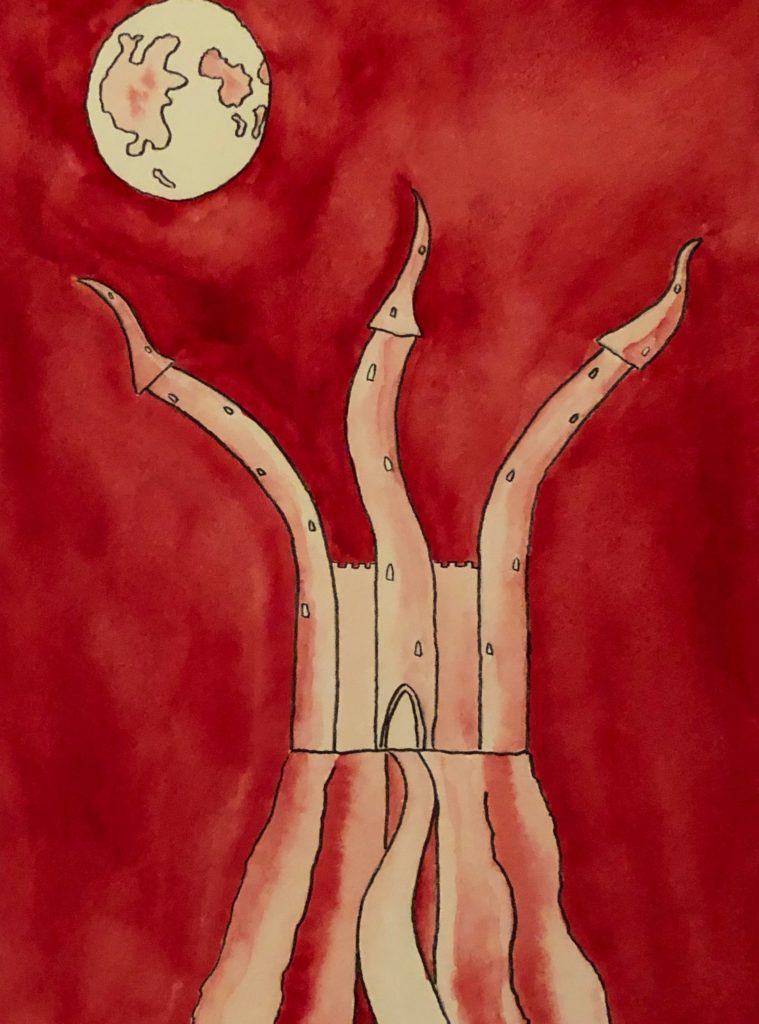Monochromatic painting is a technique where you only paint with one color. It began with the avant-garde movement as a new way to express your artwork.
Now to be clear, I’m not an avant-garde artist. Regardless, it’s a technique I’ve incorporated because it forces you to get good with the colors you’re using.
I’ve talked about cutting down to seven and even six colors before.
This, is extreme. You’ll only be using one color.
Now if you think that’s an exercise in futility, don’t worry, I’ll hold your hand through the whole process. That’s why I did the drawing for you. All you have to do is print it out and copy it accordingly.
Note that this monochromatic painting exercise isn’t limited to watercolors. That just happens to be the painting medium I use. You could use this with acrylics or oils as well. However for this exercise, we’ll use watercolors. I’m an artist who uses exclusively watercolors and gouache.
Monochromatic painting print out
This is a PDF file so you can simply print this out. You can either copy it to watercolor paper, or stick your watercolor paper into the printer and print it directly onto the watercolor paper.
Note that I don’t own a copier. However, I’ve seen others do this so I know it’s possible.
For oils or acrylics, copy it as best as you can. We’re focusing here on technique, not necessarily making a carbon copy of what I drew. You’re going to put your own spin on it anyways.
Choose a color
Now for the fun part. You get one, and only one color to work with.
I’m choosing red because why not? I’ll paint the sky red, the shadows a little less red, and where the moonlight hits even less red.
We do this by watering down the red. It’s still the same tube of red. If you’re using oils or acrylics, simply add a little white to the color you chose and even more white for the real light parts. It will be similar to the “watering down” technique in watercolors.

If I were actually selling this painting, I’d use Moonglow. It’s a Daniel Smith color that’s one of my absolute favorite colors to work with. But, I don’t want to use Moonglow for this exercise since I use it a lot in my professional works.
Keep in mind, you don’t have to use red. You could use blue, gray, purple, green, or whatever. This exercise isn’t about the color. It’s about how to use it.
Your monochromatic painting palette
You get one and only one color. In watercolors, you simply change the color by adding more or less water.
You can do this in a variety of ways. I’m sure you can do it by watering down the red in various palette reservoirs.
I simply do it by instinct. I’ve painted enough to really love using my water jars and adding more or less water to my brushes, and also painting with water. I water down the red straight from the watercolor paper.
But do this in the method you’re most comfortable with. After all, there is no absolute right or wrong way to paint. What works for you is the right way to paint.
For oils or acrylics, you’re on your own. I haven’t used them, but if you’re reading this, you’re smart, so I’m sure you can figure out how to pull this off.
The Moon
Note your light source – the moon. It’s nighttime. You have a castle, a sky, and a moon.
One of the beauties of watercolor – you get white by empty space. You’ll learn to love this technique the more you use watercolors. You have to plan in advance where you don’t want to paint.
You can do the same on your white canvas if you’re oil or acrylic. Simply don’t paint there.
For this exercise, we’re not painting the white parts of the moon. The crevices, we’ll paint lightly. For the deeper parts of the crevices, we’ll paint a little bit darker. Let’s give the moon some depth.
The sky
For the sky, we’ll simply use a simple red wash, with some added water. It will be thick and rich red so it will be darker than the castle.
If you want clouds, you can make them by grabbing a paper towel and dabbing the still wet paint to create clouds. I didn’t do this, but if you want to try it, go for it!
I’ll strategically add water here and there to make the sky more “interesting.” You can do a consistent wash or do it like I do. Either way is totally up to you.
The castle
I’m a dark fantasy artist, usually using femme fatales as my subjects. That’s why my castle is so twisted and weird. This castle cannot exist in real life. It will obviously fall down.
But, it’s fantasy. With fantasy, you don’t have to follow the laws of physics. Since wizards and witches break them all the time, as an artist, you get to break the laws of physics as well.
For painting, you want to get the castle to look three dimensional. You do that with shading. The parts that are shaded from the moon obviously should be darker. The parts lit by the moon get a lighter shade of the color you chose.
The mountain
Same concept with the mountain. It should be darker than the castle, and the parts that are shaded from the moon should be really dark.
I want to get that road looking a little lighter than the rest of the mountain. I want it to pop forward a little bit. Let’s make this as three dimensional as we possibly can.

Your results
After you’ve finished this exercise, you should be totally comfortable with monochromatic painting. You might have to do the exercise twice or even three times.
I actually incorporate dualchromatic (two colors) painting into a lot of my pieces. I’ll use Moonglow and Black as my two colors. But I’ll use other colors for the subjects.
By doing this, it makes the subjects really pop out. You have some cool colors for your dualchromatic work, and warmer colors for the subjects.
Plus dualchromaticism is great for dreams. I love to explore dreams a lot, especially when there’s a succubus or two involved.
That’s just an example of how you can use monochromatic painting in real life. Well, sort of. I cheat and use two colors. I’m sure you catch the drift though.
